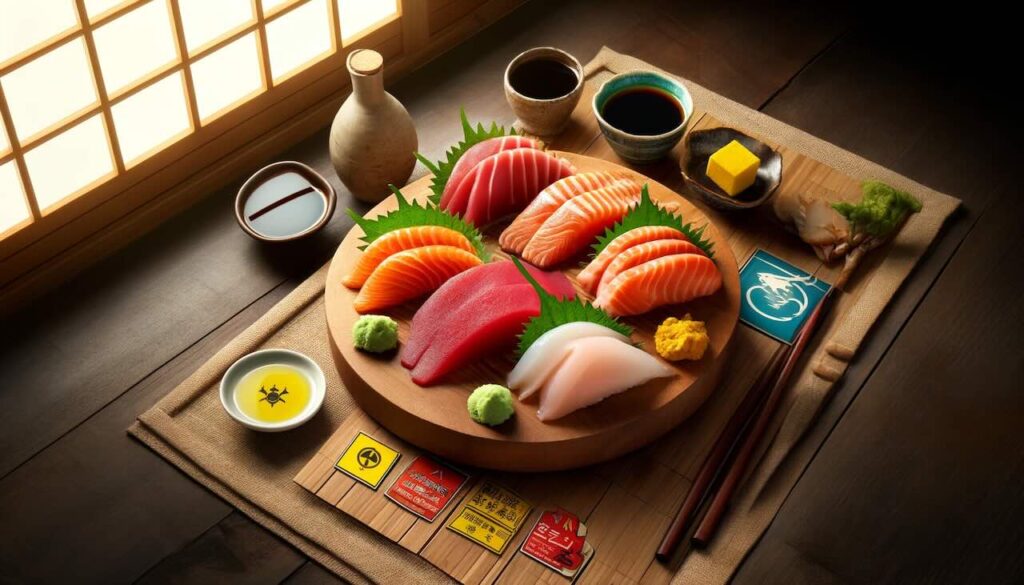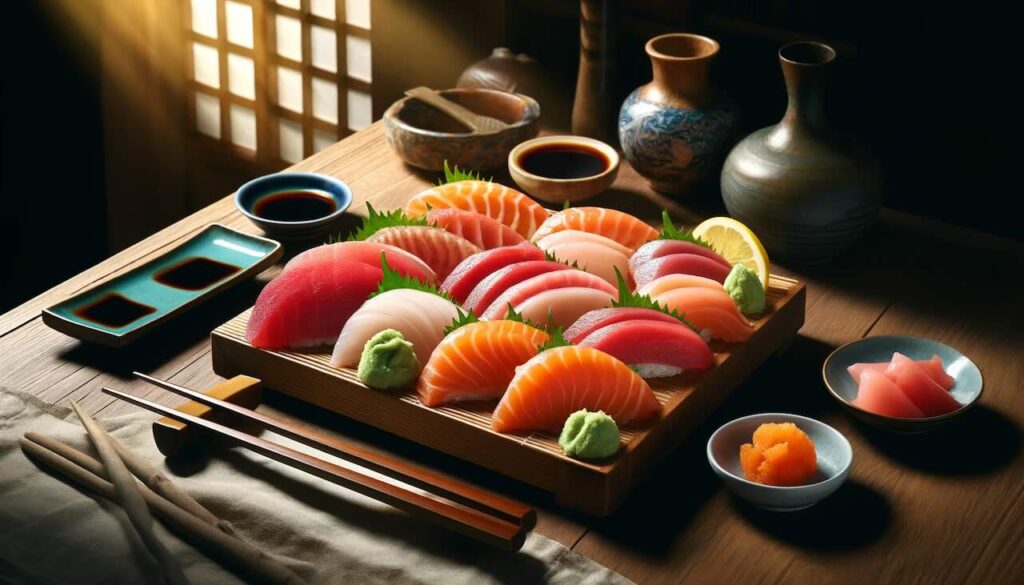Sashimi — pristine slices of raw fish artfully served — is not only a cornerstone of Japanese cuisine but also widely praised for its nutritional value. Yet, as with any raw seafood, enjoying sashimi requires both appreciation and awareness.
In this guide, we’ll explore the health benefits that make sashimi a smart dietary choice, while also addressing the risks and precautions that ensure you can enjoy it safely.
For a full introduction to sashimi’s cultural, historical, and culinary background, visit:
👉 The Complete Guide to Sashimi: Japan’s Art of Raw Fish and Cultural Refinement
The Health Benefits of Sashimi
When prepared and consumed properly, sashimi offers a range of nutritional advantages that support long-term wellness:
1. High-Quality Lean Protein
Sashimi delivers highly bioavailable protein that supports:
- Muscle maintenance and growth
- Tissue repair
- Hormone and enzyme function
2. Abundant Omega-3 Fatty Acids
Fatty fish like salmon, mackerel, and tuna are rich in EPA and DHA, two essential omega-3 fatty acids linked to:
- Lowered risk of heart disease
- Reduced inflammation (beneficial for arthritis)
- Enhanced brain function and cognitive performance
- Improved mood and mental health
3. Rich in Vitamins and Minerals
Sashimi contains important micronutrients, including:
- Vitamin D (bone and immune health)
- B-vitamins (energy metabolism)
- Selenium (antioxidant function)
- Iodine (thyroid support)
- Iron and zinc
4. Naturally Low in Saturated Fat and Carbohydrates
Compared to many Western protein sources, sashimi offers a lean, clean option that fits well within heart-healthy and weight-conscious diets.
The Risks of Eating Raw Fish
Despite its many benefits, raw fish inherently carries certain risks — primarily related to contamination, parasites, and heavy metal accumulation. Awareness of these issues allows you to enjoy sashimi safely.
Mercury and Heavy Metals
Large predatory fish accumulate higher mercury levels over time through bioaccumulation. High mercury intake may impair:
- Nervous system development (especially dangerous for fetuses and children)
- Cardiovascular health
- Kidney and cognitive function (in extreme cases)
Higher-risk fish for mercury include:
- Bluefin tuna (maguro)
- Swordfish
- Shark
- King mackerel
👉 Pregnant women, nursing mothers, children, and those planning pregnancy should limit or avoid these species.
Parasites and Foodborne Illness
Raw seafood may harbor parasites such as Anisakis, bacteria, or viruses if not properly handled or frozen. In Japan, strict safety protocols are followed:
- Fish destined for raw consumption is often flash-frozen at -60°C (-76°F) to eliminate parasites.
- Only sashimi-grade fish from reputable suppliers should be used.
Higher-risk raw items include:
- Bivalve shellfish (e.g. oysters, clams) — prone to contamination with E. coli and norovirus
- Pufferfish (fugu) — requires expert licensed preparation due to tetrodotoxin
👉 For more on how Japan ensures sashimi safety, visit:
👉 Sashimi and the Global Culture of Raw Fish: How Japan’s Delicacy Connects to a Worldwide Tradition
Who Should Exercise Extra Caution
Certain groups should be especially careful with raw seafood:
- Pregnant or breastfeeding women
- Infants and young children
- Elderly individuals
- Immunocompromised patients
These groups are more vulnerable to foodborne illnesses or mercury exposure, and should consult healthcare providers when in doubt.
How to Safely Enjoy Sashimi
By following these simple precautions, you can maximize both the health benefits and safety of sashimi:
- Source wisely: Only purchase sashimi-grade fish from trusted suppliers or eat at reputable restaurants.
- Freshness is key: Sashimi should be consumed as soon as possible after preparation.
- Mind proper storage: Keep fish cold at all times and never refreeze after thawing.
- Limit higher-mercury fish: Favor species like salmon, snapper, scallops, and shrimp for regular consumption.
- Pay attention to preparation hygiene: Avoid cross-contamination during slicing and plating.
For additional cultural and etiquette insights when eating sashimi, visit:
👉 Mastering the Art of Eating Sashimi: Japanese Etiquette, Customs, and Cultural Appreciation
Conclusion
Sashimi offers a wealth of health benefits — rich nutrition, healthy fats, lean protein, and cultural satisfaction — when enjoyed responsibly. By staying informed about sourcing, preparation, and species selection, sashimi can be both a delicious pleasure and a valuable part of a balanced, health-conscious diet.
In true Japanese culinary spirit, the key lies in respecting nature’s bounty while practicing mindfulness, balance, and seasonal awareness with every perfect slice.


